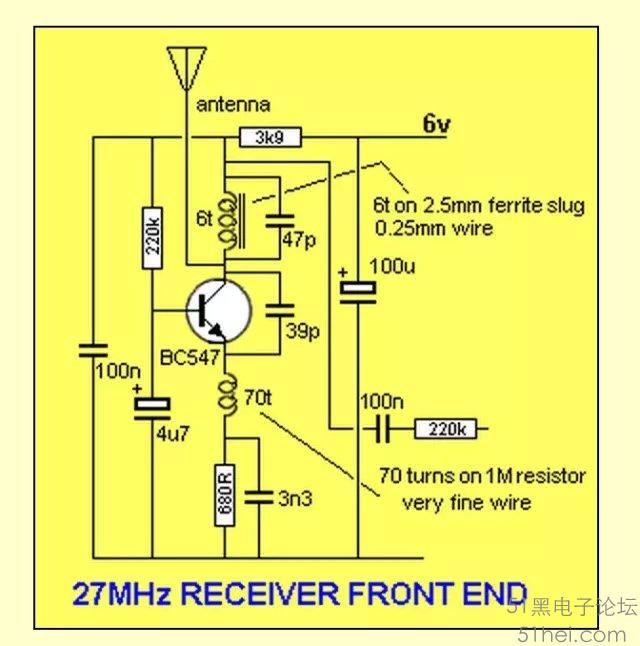|
|
对讲机应该焊接的差不多了,但是了解原理甚至比焊接更困难。 当时学习模电之类的学的就马马虎虎,感觉不是很懂。
http://www点zen22142.zen点co点uk/Circuits/rf/amrec.html
这个网络上的资料仿真了一个AM收音机,可以参考一下。其实对讲机也可以认为是一个FM收音机的简化版,只收听一个频率。
这个资料解释的更过一点,可以仔细看看。
http://www点vintage-radio点com/repair-restore-information/transistor_if-rf-stages.html
但是还是不太理解,于是仔细看了别人的讨论感觉蛮困难的。
http://forums点anandtech点com/showthread.php?t=286537
这个网址也不错,分析了这种电路,非常类似:
http://www点sentex点ca/~mec1995/tutorial/xtor/xtor7/xtor7.html
这个电路的历史已经100年了。
https://en点wikipedia点org/wiki/Regenerative_circuit
和https://en点wikipedia点org/wiki/Regenerative_circuit
这个资料也可以参考:
http://members点iinet点net点au/~cool386/6tr/srrx.html
http://www点somerset点net/arm/fm_only_lowtech.html
这个电路中文资料也没有找到,只有这个
http://www点wendangku点net/doc/561f2887ec3a87c24028c410.html
试着分析一下,由文中知道电容C4为正反馈,形成振荡电路。是所谓“起到灵敏度极高的超再生检波作用”!
后面的放大电路,应该简单一点,但是也不太明白。
开始试着使用MultiSim仿真。
 这个是从网上找的原理图,和我们的一样,需要在最下面一行增加接地符号! 这个是从网上找的原理图,和我们的一样,需要在最下面一行增加接地符号!
然后开始仿真,将这个图分成两个部分,一个为发射部分,一个为接收部分。在接收状态下,R6、C7、C8就没有了。
处于发射状态,则C14、C6就没有了,电路的拓扑也要发生变化。
还有一个问题是天线,各个器件如何选取。由于涉及振荡电路,还是蛮难的。可惜当年学艺不精啊!
继续:
昨天用了一个小时才画了了一点原理图。
今天发现应该用粘贴的方法,将原件复制,不用每次到元件库修改,并且注意Ctrl + R等快键键调整原件方向;其次,没有的原件,比如C9018,用虚拟的原件代替,然后根据器件手册,修改参数。具体实现方法在http://www点eng点auburn.edu/~niuguof/multisimdev/bjt.html 还有就是如何估算,电感线圈的值:收音机的书38页。

又: 今天下午,又仔细看了一下原理,希望彻底搞懂。发现了两个有用的资源: (1)http://www点talkingelectronics点com/projects/27MHz%20Transmitters/27MHzLinks-1.html#THE 27MHz TRANSMITTER 其中一个27M的振荡器,和我们使用的非常类似,并且作者给出了简单的解释: 2. THE RECEIVER FRONT END
The front end of a 27MHz receiver is slightly different to the front end of a 27MHz Walkie Talkie. The circuit is very lightly loaded so that it will detect the slightest signal and this makes it very sensitive.
The component that does this is the 3k9 in the power rail.
The transistor has only about 2v across it and takes less than 1mA.
The circuit is a common-base amplifier and under certain circumstances, a single transistor in this configuration will oscillate.

First, let's describe how a common-base stage works. The 220k base-bias resistor turns the stage on. The coil in the collector is the load but since it is such a low resistance, a voltage-dropping resistor has to be placed in the emitter. This resistor only limits the current through the circuit. It is by-passed with a 3n3 capacitor and does not cone into the operation of the operation of the circuit. There are two ways to turn on a transistor. one is to hold the emitter fixed and deliver a voltage and current to the base. The other is to hold the base rigid and reduce the voltage on the emitter. that is what we have done in this circuit. The 4u7 electrolytic on the base holds it rigid and the 39p reduces the voltage on the emitter to turn the transistor ON and during the other part of the 27MHz cycle, it increases the voltage on the emitter to turn it OFF. This concept must be understood before we can advance further. The circuit starts by receiving a pulse of current through the 6t coil and 47p capacitor, when it is turned on. These two components form a TUNED CIRCUIT and when they receive energy, they produce a sine-wave (sinusoidal) waveform that appears on the lower part of the tank circuit and this is passed to the emitter via the 39p. It's an amazing fact that two simple components can produce a sinewave that has an amplitude larger than the voltage applied to the pair, but this is what happens and to fully explain it, would require another chapter. However the end result is the emitter is pushed down to turn the transistor ON more and pulled up to turn it off. The 70t inductor on the emitter simply keeps it away from the 0v rail so that the pulses on the 39p can have an effect on pushing and pulling the emitter. To explain how the inductor works is very difficult, however it has the effect of allowing the 39p to push the voltage lower on the emitter, than if it were not included. If the inductor is removed, the 39p will have a very hard job to push against the 3n3. But if the 3n3 is removed the 39p will have a small difficulty pushing against the effect of the 680R. However when the inductor is added, the 39p has a much easier job of pushing and pulling the emitter. Even though this is the front end of a receiver, it is actually oscillating at 27MHz. The circuit has been built for experiential purposes to make sure the 70t inductor and 6t coil work perfectly to price a sensitive front-end. Never put a circuit on the web without building and testing it with actual components. Simulation programs cannot predict the outcome of hand-made components. The 70t inductor is about 7uH and is wound on a 1M resistor with very fine wire. The resistor can be any high value and does not play a part in the functioning of the circuit. It is just a convenient core for the winding. The carbon content of the resistor does not have any effect on the inductance.
具体计算27M的频率是,由6t的电感值和47p决定的,公式是粘贴在matlab命令窗口:
>> L=0.6*10^(-6); >> C=47*10^(-12); >> f=1/(2*pi*sqrt(L*C)) f = 2.9971e+007
6t的线圈的电感估计为0.6uH, (The 70t inductor is about 7uH,我是根据这个推算的,可能不准).
进一步参考电感计算网站,计算公式和说明http://www点eeweb点com/toolbox/coil-inductance/
仿真时,碰到几个三极管具体没有需要自己输入参数,或者找到替代的三极管。这个网站会有帮助:
http://alltransistors点com/transistor.php?transistor=21057
这个电路确实不太好理解,看了这篇文章我有点释然,很多RF工程师也犯难啊!
http://www点eix.co点uk/Articles/Radio/Welcome.htm
|
|